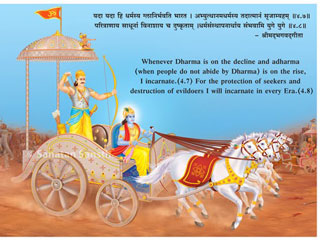Ayurveda for a healthy life ! – 8/2023

The twenty biological qualities of food
Every substance has its own qualities and action. The qualities of food and medicines are directly seen by their action and effect on a person. According to Ayurveda, there are 20 such qualities, which exert an action and have an effect on the body and mind of a person. All these are apparently physical qualities but when they act on the body, they exert a biological action. Hence, Ayurveda considers these qualities to be physical as well
as biological.
These qualities are –
| Sr | Physical qualities |
| 1. | Heavy (Guru) |
| 2. | Light (Laghu) |
| 3. | Cold (Shita) |
| 4. | Hot (Ushna) |
| 5. | Oily (Snigdha) |
| 6. | Dry (Ruksha) |
| 7. | Mild and slow acting (Manda) |
| 8. | Strong and penetrating (Tikshna) |
| 9. | Steady (Sthira) |
| 10. | Mobile (Sara) |
| 11. | Soft (Mrudu) |
| 12. | Hard (Kathina) |
| 13. | Clear (Vishada) |
| 14. | Sticky (Pishchilla) |
| 15. | Smooth (Shlakshna) |
| 16. | Rough (Khara) |
| 17. | Gross (Sthula) |
| 18. | Subtle (Sukshma) |
| 19. | Solid or semisolid (Sandra) |
| 20. | Liquid (Drava) |
The doshas, tissues and the waste products of the body have the same qualities as those of food and any other substance which is consumed. These 20 qualities of food alter the qualities and the quantity of the doshas, tissues and waste products of the body, meaning, they either increase, decrease, maintain or vitiate them.
Out of these 20 properties, hot, cold, heavy, light, oily and dry qualities are described ahead.
Man constitutes the basis or the focus of Ayurveda. Hence, the properties of food and medicines are based on their action
on the human body, e.g., camel’s milk is considered as dry. Milk
is oily and liquid. Hence, it decreases dryness. But camel’s milk is oily and fluid to a lesser extent than the human body. Hence, camel’s milk decreases the oily nature of the human body and causes dryness.
Hence, camel’s milk is administered in cases of swelling, ascites and other diseases in which the water or fat content of the body is increased.
Leafy vegetables are described as heavy in relation to the digestive system, as they are difficult to digest. But they decrease the body weight. Hence, they are considered as light with respect to the body. Til (Sesame seeds) are heavy, that is they are difficult to digest. They also increase the body weight, Hence, they are considered as heavy with respect to the body, as well as the digestive tract.
Curd and buttermilk though cold to touch, are considered
to be hot as they increase the body heat. That property, which increases in the body on consumption of a particular food item
or medicine, is considered as the property of that substance.
1. What is the scientific meaning of the words ‘hot’ and ‘cold’ with respect to food items and medicines ?
Food items and medicines which increase the heat in the body are called hot items. Out of the Panchamahabhutas, the Agni (Fire) element has a hot nature. It subdues cold. According to Ayurveda, the food items and medicines are divided into hot and cold substances, e.g., pepper and garlic are hot, while tender coconut water and cold drinks are considered as cold.
2. On what do the cold and hot properties of a substance depend?
2A. Temperature of the substance, e.g., hot drink is considered to be hot while cold drink is considered to be cold.
2B. Action of the substance on the body
Hot food items : Hot food items subdue Kapha and Vata, and increase the Pitta dosha. They increase the quantity of urine, faeces and sweat. They promote the secretion of digestive juices and hence, increase appetite. They dilate the passages and channels which carry the secretions to different parts of the body. They cause increase in sweating, increase in thirst and help in digestion of food. Usually sour, pungent and salty food items are considered as hot. Pomegranate and amalaki though sour, are not hot. Hot food items stimulate the metabolism of the body and the secretion of intracellular enzymes, thus, increasing the body heat.
Cold food items : Out of the Panchamahabhutas, Pruthvi, Apa and Vayu have a predominantly cold nature and hence, they are the constituents of cold food items. Cold substances subdue burning sensation. They nourish the tissues. The cold quality leads to increase in Kapha and Vata, and subdues the Pitta dosha. It increases the quantity of urine and decreases sweat, hunger, thirst and digestive power. It causes constriction of the body passages and promotes clotting of blood. Cold food items have a soothing effect on the mind, cells and tissues of the body. They decrease the metabolic rate of the cells and organs where they get concentrated. They give rise to goose-flesh, nausea and constipation. Usually bitter, astringent and sweet food items are cold, i.e., they have a cooling effect on the body. Amalaki (Avala) and pomegranate though sour, have a cooling action.
Thus, cold and hot properties of a substance describe the pharmacological qualities and action of the substance, and not
its physical qualities or action.
| Hot food items | Cold food items | |
| 1. Cereals | Rice, wheat and yava (Barley) | |
| 2. Pulses | Udid (Black gram), kulith (Horse gram) and val | Chana (Gram), peas, mung (Green gram) and masur (Lentil) |
| 3. Nuts, dry fruits and oil seeds | Atasi (Linseed), til (Sesame seeds), mustard, eranda (Castor), almond, walnut, bhallataka (Marking nut) | Coconut oil, charoli, kharik, dates and coconut |
| 4. Vegetables | Mustard leaves, drumstick, drumstick leaves, ambat chuka (Chukra), carrot, carrot leaves, brinjal, snake gourd, red onion, lady finger and curry patta | Generally leafy vegetables are cool. Spinach, tandulja, banana flower, cucumber, karela (Bitter gourd), tondali, kushmanda (Ash gourd) and singada (Water chestnut) |
| 5. Fruits | Orange, sour sweet lime, raw mango and bel (Bilva) fruit |
Grapes, ripe mango, apple, bhokar, banana, sweet lime, dates, watermelon, guava, jackfruit, khirni, custard apple and jamun |
| 6. Milk products | Milk of a camel and donkey, curd and buttermilk prepared from all types of milk | Milk of a cow, buffalo, human milk, butter and ghee prepared from the milk of a cow and buffalo |
| 7. Meat | Generally, meat of all animals is hot. Meat of sheep and peacock, chicken, pork, eggs of birds and sea fish | Tortoise shells, meat of deer, lava, rabbit, frog and fish from lakes |
| 8. Sugar based products | Honey | Sugar |
| 9. Wine | All wines are hot | |
| 10. Spices | Generally, all spices are hot. Ginger, ajamoda (Celery), garlic, mustard, badishep (Fennel seeds), pippali, pepper, vavding, asafoetida, cumin seeds, turmeric, kokam and shahajire | Betelnut and cardamom |
| 11. Drinking water and beverages | Hot drinks and hot water | Rain water, cold water, tender coconut water and cold drinks |
4. Who should eat hot food items and who should avoid them ?
In winter, everyone should preferably eat hot food items. Obese, sluggish (lazy) people, thin but active people and people with Vata and Kapha constitutions, should preferably eat hot food items. They are useful in cold, cough, breathlessness and hiccoughs. Hot food items are easy to digest. They relieve abdominal distension and stimulate appetite.
Consumption of hot food items should be avoided in summer and also by people with a Pitta constitution. They should be avoided by people suffering from bleeding disorders, acidity, giddiness and burning sensation.
5. Who should eat cold food items and who should avoid them ?
Individuals with a warm body, high body temperature, excessive sweating and those who cannot tolerate the hot environment, should preferably consume cold food items. Everyone should give preference to cold food items in summer. Cold food items are useful in giddiness, fainting, vomiting and bleeding disorders.
If cold drinks and ice creams are taken in excess, they decrease the secretion of enzymes in the stomach and the
process of digestion may come to a standstill, for about half an hour. Cold food items should be avoided by individuals suffering from cold, cough, breathlessness and swelling of the body.

 Radiant Thoughts of Sachchidananda Parabrahman (Dr) Jayant Athavale
Radiant Thoughts of Sachchidananda Parabrahman (Dr) Jayant Athavale Law banning Conversion of Religion is against Individual Freedom : Babbles Former Judge S Muralidhar
Law banning Conversion of Religion is against Individual Freedom : Babbles Former Judge S Muralidhar Editorial : Khalistan, Balochistan and Pakistan
Editorial : Khalistan, Balochistan and Pakistan After India becomes a ‘Hindu Rashtra’, Russia will embrace Hinduism and spread it globally : Nostradamus’ Prophecy
After India becomes a ‘Hindu Rashtra’, Russia will embrace Hinduism and spread it globally : Nostradamus’ Prophecy ‘Halt Public Spending on Aurangzeb’s Tomb, Prioritise Maharashtra’s Heritage’ : HJS
‘Halt Public Spending on Aurangzeb’s Tomb, Prioritise Maharashtra’s Heritage’ : HJS Noise Pollution, Loudspeakers, and the Law
Noise Pollution, Loudspeakers, and the Law